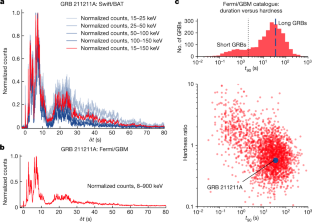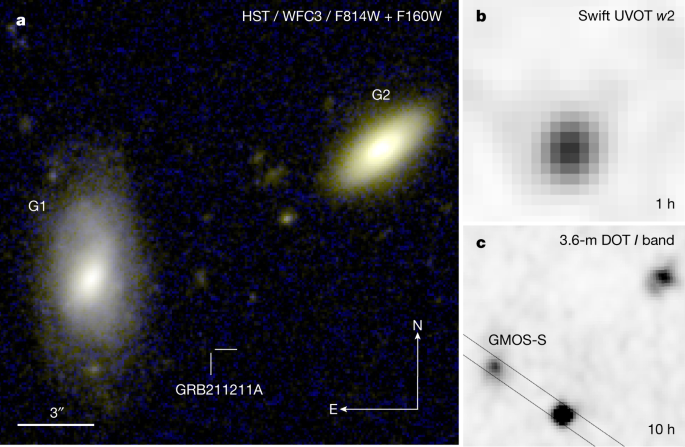長いガンマ線バーストは中性子星の合体で発生する可能性があることが判明 Long gamma-ray bursts can be generated by neutron star mergers, study finds
2022-12-07 ノースウェスタン大学
2021年12月に50秒の長尺GRBを検出した後、研究チームは長尺GRBの残光(超新星の前にしばしば見られる、信じられないほど明るく、速く消えるバースト光)の探索を開始した。これは、中性子星と他の天体(別の中性子星やブラックホール)が合体した後にしか起こらない珍しい現象である。
今回の発見は、長い間信じられてきたGRBの形成過程を覆すとともに、宇宙で最も重い元素がどのように形成されたかという謎の解明にもつながるものである。
2021年12月、ニール・ゲールズ・スウィフト観測所のバースト・アラート望遠鏡とフェルミ・ガンマ線宇宙望遠鏡が、GRB211211Aと名付けられた明るいガンマ線のバーストを発見した。長さ50秒あまりのGRB211211Aは、当初は特に何もないように見えた。しかし、約11億光年の距離にあり、地球から比較的近い距離にある。天体物理学者たちは、電磁スペクトル全体を観測できる多くの望遠鏡を使って、この「近い」現象を詳しく研究することにした。
近赤外線でこの現象を撮影するために、研究チームはすぐにハワイのジェミニ天文台で撮影を開始した。
近赤外線画像を調べた結果、研究チームはすぐに消えてしまう信じられないほど暗い天体を発見しました。超新星はこれほど早く消えず、もっと明るいので、研究チームはこれまで不可能と思われていた意外なものを発見したことに気づいた。
<関連情報>
- https://news.northwestern.edu/stories/2022/12/surprise-kilonova-upends-established-understanding-of-long-gamma-ray-bursts/
- https://www.nature.com/articles/s41586-022-05390-w#citeas
350 Mpcにある長周期ガンマ線バーストに続くキロノバ A kilonova following a long-duration gamma-ray burst at 350 Mpc
Jillian C. Rastinejad,Benjamin P. Gompertz,Andrew J. Levan,Wen-fai Fong,Matt Nicholl,Gavin P. Lamb,Daniele B. Malesani,Anya E. Nugent,Samantha R. Oates,Nial R. Tanvir,Antonio de Ugarte Postigo,Charles D. Kilpatrick,Christopher J. Moore,Brian D. Metzger,Maria Edvige Ravasio,Andrea Rossi,Genevieve Schroeder,Jacob Jencson,David J. Sand,Nathan Smith,José Feliciano Agüí Fernández,Edo Berger,Peter K. Blanchard,Ryan Chornock,Bethany E. Cobb,Massimiliano De Pasquale,Johan P. U. Fynbo,Luca Izzo,D. Alexander Kann,Tanmoy Laskar,Ester Marini,Kerry Paterson,Alicia Rouco Escorial,Huei M. Sears & Christina C. Thöne
Nature Published:07 December 2022
DOI:https://doi.org/10.1038/s41586-022-05390-w

Abstract
Gamma-ray bursts (GRBs) are divided into two populations1,2; long GRBs that derive from the core collapse of massive stars (for example, ref. 3) and short GRBs that form in the merger of two compact objects4,5. Although it is common to divide the two populations at a gamma-ray duration of 2 s, classification based on duration does not always map to the progenitor. Notably, GRBs with short (≲2 s) spikes of prompt gamma-ray emission followed by prolonged, spectrally softer extended emission (EE-SGRBs) have been suggested to arise from compact object mergers6,7,8. Compact object mergers are of great astrophysical importance as the only confirmed site of rapid neutron capture (r-process) nucleosynthesis, observed in the form of so-called kilonovae9,10,11,12,13,14. Here we report the discovery of a possible kilonova associated with the nearby (350 Mpc), minute-duration GRB 211211A. The kilonova implies that the progenitor is a compact object merger, suggesting that GRBs with long, complex light curves can be spawned from merger events. The kilonova of GRB 211211A has a similar luminosity, duration and colour to that which accompanied the gravitational wave (GW)-detected binary neutron star (BNS) merger GW170817 (ref. 4). Further searches for GW signals coincident with long GRBs are a promising route for future multi-messenger astronomy.



